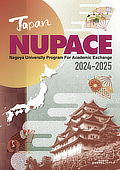Top Page > Student Life > Living in Japan
Living in Japan
1. Health Care
All foreign nationals who reside in Japan are required to take out the Japan National Health Insurance (JNHI). For a monthly fee of approxi-mately ¥ 1,700, JNHI policyholders are entitled to a 70% discount on most medical and dental fees incurred.
NUPACE appreciates that many incoming students are covered by private/home university insurance schemes.
However, in consideration of the fact that, 1) medical expenses in Japan are relatively high, 2) Japanese medical facilities do not accept foreign insurance policies in lieu of payment and, 3) students will, therefore, have to wait a minimum of two months to be reimbursed by their home insurance policies, NUPACE requires Japan National Health Insurance subscription from all students.
For details, please refer to '1. Japan National Health Insurance, Medical and Health Care', ALWAYS NU site
Nagoya University houses a Health Administration Office at which emergency treatment for illness and injury is performed free of charge. The Office additionally serves to refer students to hospitals, where deemed necessary.
2. Personal Liability Insurance
The Nagoya University Co-operative offers a personal liability insurance at an extremely competitive rate.
In addition to the Japan National Health Insurance, all NUPACE students are required to take out this insurance during their exchange at Nagoya University at the reasonable cost of ¥1,800 per year.
3. Part-time Work
International students intending to engage in remunerative activities in Japan should declare that they wish to work part-time at the port of entry and receive a stamp of permission on their Residence Card at this time (application forms are available at major airports and also downloadable from the Ministry of Justice at https://nupace.iee.nagoya-u.ac.jp/en/pdf/PartTimeWorkPermission.pdf.
Where permission is granted, students may work for a maximum of twenty-eight hours per week dur-ing the semester, and up to eight hours per day during long vacations.
4. Climate & Clothes
The climate in Nagoya is distinguished by its humidity in summer and marked seasonal changes.
In general, autumn is dry, cool, and pleasant.
Winter (December to February) can prove cold with minimum temperatures of -5℃ (23℉), highs of 9℃(48℉), piercing winds and the occasional snowfall.
Spring (March to May) is the time of cherry blossoms and new beginnings, including the Japanese academic and fiscal years.
Summer, heralded by the ‘rainy season’ in June, is extremely hot and muggy with temperatures peaking at around 38℃ (100℉) in August.
Temperatures start to drop in mid-September and around this time the Japanese archipelago experiences the ‘typhoon season’.
Students should bear these seasonal changes in mind when choosing what clothes to bring to Japan.
They are also advised that it may prove challenging to find larger than average clothes and shoe sizes.
For more information on Student Life, please refer to the ALWAYS NU site at https://sed.adm.nagoya-u.ac.jp/en/index.html




